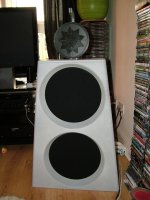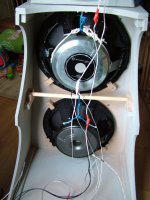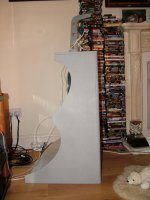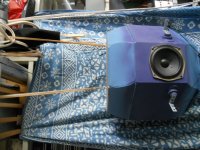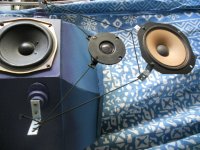Suspended drivers - 3 way - open baffle
Hi Guys,
I made these in 2010... Still love the sound but not got the space anymore.
I think suspended drivers work best in open baffles.
The attached used a Beyma SM115K 15 inch bass, Precision Devices PD 158 15 inch low midrange and the Manger driver above 500Hz.
Battery powered DEQX run all Eq and crossovers.
The 15 inch drivers were suspended on soft polyprop cord from wooded dowels.
The drivers were not bolted in place, they were suspended a few millimetres away from the rear of the baffle and then pushed gently against the baffle via Sorbothane blocks. Large sorbothane gasket in front of the speaker chassis and Sorbothane blocks behind it, the driver itself never touched any surface of the baffle.
The baffle was birch Ply and MDF, the front baffle was CNC'd out of 75mm thick MDF, the rest was all cut from 12mm birch.
The 15 inch driver are both rather special, really effortless and natural and also capable of filling a large room with powerful music...110dB peaks at the (4meter) listening position!
Even at max party volumes the cabinets were inert, no nasty panel vibrations induced from the drivers. Its hard to more definitive because every surface in the room was being energised by the sound energy i.e. sofa tables, walls etc. but the sound stage remained stable.
Bottom line is this method ( or similar suspended & open baffle combo's) is the only method I am aware of that TOTALLY eliminates all cabinet resonance and effects.
You can eliminate cabinet resonance by CNC' ing cabinets from solid blocks of alloy / phenolic resin / synthetic stone etc and get 200Kg non resonant "containers"...
BUT you still have all the usual internal reflections bouncing around and then emerging out through the cone ( out of phase) sonic problems...
You can go open baffle and get rid of the internal resonance, but you still have cabinet resonance....
Only combining Open Baffle and fully isolated / suspended drivers will let you hear the drivers and crossovers without and cabinet distortions.
Cheers
Derek.
Hi Guys,
I made these in 2010... Still love the sound but not got the space anymore.
I think suspended drivers work best in open baffles.
The attached used a Beyma SM115K 15 inch bass, Precision Devices PD 158 15 inch low midrange and the Manger driver above 500Hz.
Battery powered DEQX run all Eq and crossovers.
The 15 inch drivers were suspended on soft polyprop cord from wooded dowels.
The drivers were not bolted in place, they were suspended a few millimetres away from the rear of the baffle and then pushed gently against the baffle via Sorbothane blocks. Large sorbothane gasket in front of the speaker chassis and Sorbothane blocks behind it, the driver itself never touched any surface of the baffle.
The baffle was birch Ply and MDF, the front baffle was CNC'd out of 75mm thick MDF, the rest was all cut from 12mm birch.
The 15 inch driver are both rather special, really effortless and natural and also capable of filling a large room with powerful music...110dB peaks at the (4meter) listening position!
Even at max party volumes the cabinets were inert, no nasty panel vibrations induced from the drivers. Its hard to more definitive because every surface in the room was being energised by the sound energy i.e. sofa tables, walls etc. but the sound stage remained stable.
Bottom line is this method ( or similar suspended & open baffle combo's) is the only method I am aware of that TOTALLY eliminates all cabinet resonance and effects.
You can eliminate cabinet resonance by CNC' ing cabinets from solid blocks of alloy / phenolic resin / synthetic stone etc and get 200Kg non resonant "containers"...
BUT you still have all the usual internal reflections bouncing around and then emerging out through the cone ( out of phase) sonic problems...
You can go open baffle and get rid of the internal resonance, but you still have cabinet resonance....
Only combining Open Baffle and fully isolated / suspended drivers will let you hear the drivers and crossovers without and cabinet distortions.
Cheers
Derek.
Attachments
Only combining Open Baffle and fully isolated / suspended drivers will let you hear the drivers and crossovers without and cabinet distortions.
Cheers
Derek.
And how do you achieve that ?
Ps. And 'bouncing' is the key ...
Attachments
Last edited:
I did it this way. Stig Erik's build may also be of interest, though neither his build or mine is optimal in that no real effort's made to obtain torque balance---if one seeks to minimize parasitic vibrations the ideal motion is purely linear translation in response to soley cone thrust, which requires zero net torque in order to avoid any rotational components. This is why all my hangs are pantograph-like. I can't really say if the likeness is good enough but neither is it poor; THD is below my -50 to -55dB measurement noise floor. The distortion increase from decidedly off balance configurations is measureable easily enough.And how do you achieve that?
With a full range some sort of rear wave control is required for adequate SPL, which in turn means some kind of baffle, box, pipe, or what have you. Full range implementations tend to be better about avoiding box pressurization and associated internal vibration sources than multiway---more BVRs, horns, TLs, and such in full range with more attention paid to stuffing, compliance volumes, and other forms of resonance control. If one, for a moment, assumes panel vibrations and such aren't an issue, this leaves the problem of the driver axis is rarely aligned with the enclosure's center of mass. This produces a torque imbalance and so the speaker will tend to rotate when hung. I rather suspect the resulting distortion will generally be negligible, though, most enclosures being heavy compared to the few grams of moving mass in a typical full range driver. Given the smallness of the angular deflections and compliance of typical speaker supports (flooring or shelves) it wouldn't surprise me if it turned out there's no measureable difference between hanging and normal placement in this regard. Similarly, it would surprise me if hanging did anything to mitigate cabinent vibration caused by pressurization.
There does seem to be benefit in providing low order modes which accomodate driver thrust. Linkwitz and others have found supporting a driver near its center of mass rather than from its mounting flange reduces basket and enclosure vibration. My own experience is similar, having been able to produce measurable acoustic artifacts from support structures which seemed solid but turned out to have resonance problems until the drivers were decoupled by hanging or other means. It is my hunch the majority of cabinet vibrations are produced by mechanical coupling to the driver rather than acoustically generated but I've not seen data on this.
Since most full rangers use unsealed cabinets there's no strict requirement for a tight seal around the driver. mige0 did a hanging dipole build a few years ago with a 300mm driver hung such that it was centered in a 305mm hole in baffle which was also hung, yielding a small air gap all the way around driver. One could easily bang out a couple simple full range MLTLs and try something similar; attach the driver with screws as usual one as a control and hang the driver from within the enclosure to align with its hole in the other. Measure the two and see if there's a detectable difference. If anyone had an old MLTL pair lying around they weren't using and didn't mind modifying that would make the experiment super easy.
I didn't explain how it works ( apart from those silly experiments that you mentioned about placing the speaker very near to the hole and such things like OB that don't take into account that what the driver produce with the back radiation is the negation of what it emits frontally....)
the trick is to make the speaker ( or sub-part of it, since each driver works in a dedicated-specialized band) able to move but out of working band.
That is achieved with rubber bands, which are springs, and they must be tensioned till the load ( the speaker, or the cabinet as a whole) can oscillate at subsonic frequency. This basic principle might (....) be extended to the whole system.
the trick is to make the speaker ( or sub-part of it, since each driver works in a dedicated-specialized band) able to move but out of working band.
That is achieved with rubber bands, which are springs, and they must be tensioned till the load ( the speaker, or the cabinet as a whole) can oscillate at subsonic frequency. This basic principle might (....) be extended to the whole system.
If by out of band motion you're referring to the decoupling which occurs above a suspension's resonant frequency that's trivially acheived with rather short pendulums, be the members rigid or no (small displacement formula's here; for a 100mm pendulum the frequency's a rather thoroughly subsonic 1.6Hz). I agree pendulum baseed decoupling can be constructed with rubber bands as members (or any number of materials) but am unsure what vibration mitigation benefit the elasticity of a tensioned spring positioned more or less orthogonal to the piston axis offers; can you be specific as to the method of operation?
I think if you review open baffle design you'll find considerable awareness of cancellation between front and back waves. Try here for a start. For small gap decoupling I've used the superposition method discussed here; if you check it out you may find it's less silly than you thought.
I think if you review open baffle design you'll find considerable awareness of cancellation between front and back waves. Try here for a start. For small gap decoupling I've used the superposition method discussed here; if you check it out you may find it's less silly than you thought.
Suspended or " Flying " drivers
Twest is right....
There is a lot of good "peer reviewed" (some of the big brains on this site!) explanation of the maths and physics behind this principal.
Its actually counter intuitive, I couldn't believe that a " suspended" 15 or 18 inch Pro driver would not start swinging around when pumping 500 watts of low synth bass through it....
It just sounds really really clean with great punch and dynamics....The exact opposite of what I thought it would sound like.
If you have the money & space...Imagine a DEQX or good DSP crossover Eq package running the crossovers.
Add a 15 or 18 inch Pro bass, a 6 or 8 inch midrange and a Beyma TPL tweeter all suspended by their magnets on soft poly prop cord from a light but rigid alloy space frame. Each driver has a 20mm Neoprene gasket on the front side of the chassis.
The assembly is free standing in your listening room, nice sound but no bass and thin low midrange.... Now slide up a beautiful trapezoid custom GRP baffle with VPL sides, all curved and flowing to allow correct time alignment of the drivers. The baffle mates up perfectly with each driver gasket just touching the inside of the baffle.
Suddenly its a very very different sound, Zero cabinet colouration, each driver working in its ideal pass band, some of you will know what I mean!!
Especially Mige0 and Stig Erik, they both developed very good suspended designs.
Have a site search, the posts from these guys are really great, very educational and Stig Erik builds prototypes at a hell of a pace!
Hope this sparks some research into this massively under exploited concept.
Cheers
Derek.
Twest is right....
There is a lot of good "peer reviewed" (some of the big brains on this site!) explanation of the maths and physics behind this principal.
Its actually counter intuitive, I couldn't believe that a " suspended" 15 or 18 inch Pro driver would not start swinging around when pumping 500 watts of low synth bass through it....
It just sounds really really clean with great punch and dynamics....The exact opposite of what I thought it would sound like.
If you have the money & space...Imagine a DEQX or good DSP crossover Eq package running the crossovers.
Add a 15 or 18 inch Pro bass, a 6 or 8 inch midrange and a Beyma TPL tweeter all suspended by their magnets on soft poly prop cord from a light but rigid alloy space frame. Each driver has a 20mm Neoprene gasket on the front side of the chassis.
The assembly is free standing in your listening room, nice sound but no bass and thin low midrange.... Now slide up a beautiful trapezoid custom GRP baffle with VPL sides, all curved and flowing to allow correct time alignment of the drivers. The baffle mates up perfectly with each driver gasket just touching the inside of the baffle.
Suddenly its a very very different sound, Zero cabinet colouration, each driver working in its ideal pass band, some of you will know what I mean!!
Especially Mige0 and Stig Erik, they both developed very good suspended designs.
Have a site search, the posts from these guys are really great, very educational and Stig Erik builds prototypes at a hell of a pace!
Hope this sparks some research into this massively under exploited concept.
Cheers
Derek.
Just an idea: a
Speaker is made up of moving and stationary parts/components. Afaiu the moving parts need a solide/stable base/"setting" (the stable parts) to preform their function correctly -> so suspending speakers kind of defeats that.
Seems to me one creates a "swinging/unstable system with its own resonance. Not a good idea i think.
Speaker is made up of moving and stationary parts/components. Afaiu the moving parts need a solide/stable base/"setting" (the stable parts) to preform their function correctly -> so suspending speakers kind of defeats that.
Seems to me one creates a "swinging/unstable system with its own resonance. Not a good idea i think.
Equal and opposite
Hi Twest,
I have had a quick read at some of your posts as you suggested, very thought provoking and well researched stuff....Thanks!
I have question slightly unrelated but maybe the answer is relevant here.
I have always believed that cone drivers have a fundamental flaw that is masked by the marketing hype around cone rigidity and the ability of the cone to remain " pistonic" .
In my opinion the real "elephant in the room" is the fact that the cone never responds in a pistonic manner.....
Imagine a driver, the cone sitting perfectly still in the rest position, "position X".
Now give the driver a single impulse ( say a drum strike) the voice coil and cone shoots out ( creating a air compression) in response to the electrical impulse, working against the elastic strength of the surround and cone suspension and the cone extends out to a maximum point having converted all its kinetic energy into potential energy in the elastic surround / suspension.
So far so good, but now the cone shoots back towards its starting position " X" BUT....The cone overshoots position ( creating an air rarefaction) X due to Momentum!
Then it is drawn back by the suspension and overshoots again and so on....This cone oscillation is a serious problem! It causes ghost echoes ( false compression / rarefaction in air pressure) and is easily measureable and documented.
For example one of the highest quality midranges the legendary ATC 4 inch dome has a setting time of over 270ms, a large pro woofer....well you can go away and make a cup of tea before one of these babies stops bouncing around!!!
Now my question...Sorry about the preamble...
If a suspended driver does not start to oscillate when under power is it due to the above to some degree ie " For every action there is an equal and opposite reaction"?
Thanks in advance
Derek.
Hi Twest,
I have had a quick read at some of your posts as you suggested, very thought provoking and well researched stuff....Thanks!
I have question slightly unrelated but maybe the answer is relevant here.
I have always believed that cone drivers have a fundamental flaw that is masked by the marketing hype around cone rigidity and the ability of the cone to remain " pistonic" .
In my opinion the real "elephant in the room" is the fact that the cone never responds in a pistonic manner.....
Imagine a driver, the cone sitting perfectly still in the rest position, "position X".
Now give the driver a single impulse ( say a drum strike) the voice coil and cone shoots out ( creating a air compression) in response to the electrical impulse, working against the elastic strength of the surround and cone suspension and the cone extends out to a maximum point having converted all its kinetic energy into potential energy in the elastic surround / suspension.
So far so good, but now the cone shoots back towards its starting position " X" BUT....The cone overshoots position ( creating an air rarefaction) X due to Momentum!
Then it is drawn back by the suspension and overshoots again and so on....This cone oscillation is a serious problem! It causes ghost echoes ( false compression / rarefaction in air pressure) and is easily measureable and documented.
For example one of the highest quality midranges the legendary ATC 4 inch dome has a setting time of over 270ms, a large pro woofer....well you can go away and make a cup of tea before one of these babies stops bouncing around!!!
Now my question...Sorry about the preamble...
If a suspended driver does not start to oscillate when under power is it due to the above to some degree ie " For every action there is an equal and opposite reaction"?
Thanks in advance
Derek.
At the extremes, such floating might be achieved magnetically (though I think this might be a little more costly than rubber bands--which is actually a rather handy approach).let's see - wouldn't that be "suspended" (or even "hung") ? "floating" suggests resting on the surface of a liquid or in mid air, without any additional physical support

I have always believed that cone drivers have a fundamental flaw that is masked by the marketing hype around cone rigidity and the ability of the cone to remain " pistonic" .
In my opinion the real "elephant in the room" is the fact that the cone never responds in a pistonic manner.....
Imagine a driver, the cone sitting perfectly still in the rest position, "position X".
Now give the driver a single impulse ( say a drum strike) the voice coil and cone shoots out ( creating a air compression) in response to the electrical impulse, working against the elastic strength of the surround and cone suspension and the cone extends out to a maximum point having converted all its kinetic energy into potential energy in the elastic surround / suspension.
So far so good, but now the cone shoots back towards its starting position " X" BUT....The cone overshoots position ( creating an air rarefaction) X due to Momentum!
Then it is drawn back by the suspension and overshoots again and so on....This cone oscillation is a serious problem! It causes ghost echoes ( false compression / rarefaction in air pressure) and is easily measureable and documented.
For example one of the highest quality midranges the legendary ATC 4 inch dome has a setting time of over 270ms, a large pro woofer....well you can go away and make a cup of tea before one of these babies stops bouncing around!!!
Now my question...Sorry about the preamble...
If a suspended driver does not start to oscillate when under power is it due to the above to some degree ie " For every action there is an equal and opposite reaction"?
Thanks in advance
Derek.
Derek,
When I designed my 8" drivers and AMTs I addressed also these issues.
The AMTs are best suited for the suspension in "free air" due to the movements of the diaphragm are left - right and cancels out any forces of movement in those directions, as they are true dipole they will create over and under pressure (front / back) that will move them in those directions, but if they have enough mass that will be very little.
However when one AMT midrange in a baffle / waveguide have a -3dB point at 100Hz and suspended in free air only 1500Hz I can not see any reason to suspend them in free air.
I have also listened to them (and the 8" drivers) suspended in free air and could not find any positive effects - only negative.
However the Beyma AMTs have maybe 100 times more spring effect than my AMTs so that could explain why there are so different experiences.
When I evaluated Mundorf AMTs I asked them why the AMTs was mechanically singing in the 10 - 12kHz area at a 60dB acoustic output level when running them at 100dB..
I got no explanation, and quickly sold the Mundorfs and designed and built my own...
Essentially what you're asking is whether suspension affects the damping ratio of the driver's suspension. The answer is no, it doesn't. Changing how the driver's held in position doesn't change the mechanical properties of the surround, spider, and cone itself.If a suspended driver does not start to oscillate when under power is it due to the above to some degree ie " For every action there is an equal and opposite reaction"?
mige0 has some interesting ideas about high Qms/low Rms drivers you might find interesting; searching his posts and my posts for Qms is probably the easiest way to find the discussions.
Empirically, mige0, Stig Erik, and I have all posted measurements showing it's not a problem. Even with lots of effort and attention to minimizing ambient noise my measurement floor is still about -55dBFS. When I went through the exercise of pulling the drivers out my box speakers and suspending them I measured a drop of 5-10dB to the floor, so all I can objectively say is hanging at least that much better than a rather well built commercial box. Subjectively I can't feel anything in the lines.Not meaning to sound cantankerous or anything, but don't strings and cables vibrate as well, so isn't there the possibility that one is simply creating a stringed instrument here in place of a wooden one?
Stig Erik did have some suspension noise issues in one of his early builds where he used metal chain and could hear the links click against each other. That's why he switched over to the rubber rope expansion units. I'm sure someone'll manage to hit a resonance eventually but it shouldn't be hard to fix. Mathematically it's easy enough to apply string harmonic oscillator physics and estimate the halfwave resonance frequency. For the ropes I use it's well below the passband of each driver.
In practice the torque balance I was talking about a few posts back may be more of a concern, though the only driver I've been able to measure it on is a BG Radia Neo 3. The 3 is pretty light and required deliberately awful setup to definitively exhibit the problem.
Last edited:
After reading mige0's ideas on flying pendulums vs rigid baffles, I take back any comments I made about speakers swinging. This kind of work only goes to show that it is the things we take to be intuitively true that are often most in need of critical scrutiny.
Very interesting work being done here that seems to have a lot of potential. I love this kind of innovative, experimental work. Great stuff!
Very interesting work being done here that seems to have a lot of potential. I love this kind of innovative, experimental work. Great stuff!
- Status
- This old topic is closed. If you want to reopen this topic, contact a moderator using the "Report Post" button.
- Home
- Loudspeakers
- Full Range
- Floating speaker enclosures
